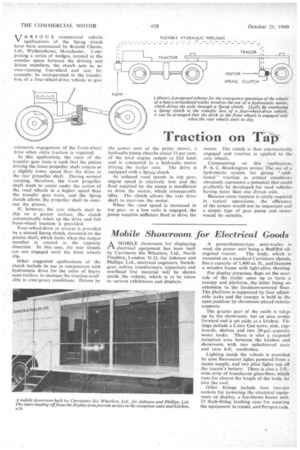Traction on Tap
Page 64

If you've noticed an error in this article please click here to report it so we can fix it.
VARIOUS commercial vehicle applications of the Sprag clutch have been announced by Renold Chains, Ltd., Wythenshawe. Manchester. Comprising a series of wedges, located in the annular space between the driving and driven members, the clutch acts as an over-running free-wheel and can. fo • example, be incorporated in the transfe box of a four-wheel-drive vehicle to givo
iutomatic engagement of the front-wheel Jrive when extra traction is required.
In this application, the ratio of the transfer gear train is such that the pinion driving the front propeller shaft rotates at a slightly lower speed than the drive to the rear propeller shaft. During normal running, therefore, the front propeller shaft tends to rotate under the action of the road wheels at a higher speed than the transfer gear train, and the Sprag clutch allows the propeller shaft to overrun the pinion.
if, however, the rear wheels start to slip on a greasy surface, the clutch automatically takes up the drive and full front-wheel traction is provided.
Four-wheel-drive in reverse is provided by a second Sprag clutch, mounted on the pinion shaft, which locks when the output member is rotated in the opposite direction. In this case, the rear wheels are not engaged until the front wheels slip.
Other suggested applications of the clutch include its use in conjunction with hydrostatic drive for the axles of heavy semi-trailers, to increase the traction avail1.ble in emergency conditions. Driven by the power unit of the prime mover, a hydraulic pump absorbs about 33 per cent. of the total engine output at full load, and is connected to a hydraulic motor driving the trailer axle. The drive is equipped with a Sprag clutch.
At reduced road speeds in top gear, engine speed is relatively low and the fluid supplied by the pump is insufficient to drive the motor, which consequently idles. The clutch allows the axle drive shaft to over-run the motor.
When the road speed is increased in top gear, or a low ratio is engaged, the pump supplies sufficient fluid to drive the motor. The clutch is then automatically engaged and traction is applied to the axle wheels.
. Commenting on this application, P. A. C. Brockington writes: The use of a hydrostatic system for giving " additional " traction in critical conditions obviously represents a potential that could profitably be developed for road vehicles having more than one driven axle.
Because extra traction is rarely required in typical operations, the efficiency of the system would not be important and a simple type of gear pump and motor would be suitable.




















































































































